基于C++的OpenGL 05 之坐标系统
1. 引言
本文基于C++语言,描述OpenGL的坐标系统
前置知识可参考:
笔者这里不过多描述每个名词、函数和细节,更详细的文档可以参考:
2. 概述
OpenGL中坐标变换的流程如下图:
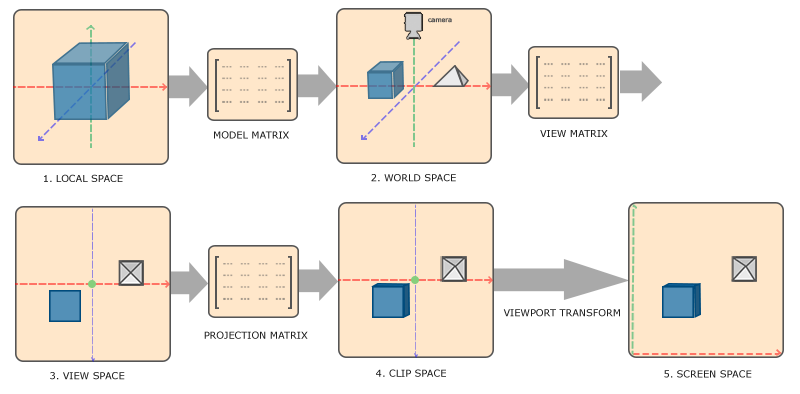
有图可知:
-
创建一个物体到屏幕绘制需要三个矩阵变换:模型(Model)、观察(View)、投影(Projection)(即,MVP)
-
裁剪坐标:
投影时主要有两者投影方式:
- 正交投影:平行视角

- 透视投影:近大远小
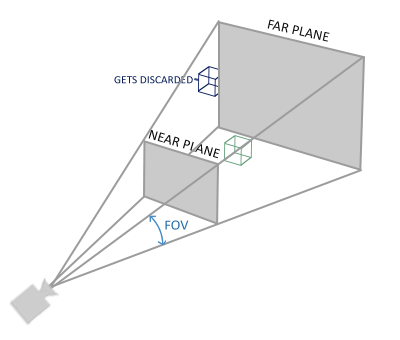
3. 编码
编码实现只需设置MVP矩阵即可
设置Model矩阵:
glm::mat4 model = glm::mat4(1.0f); model = glm::rotate(model, glm::radians(-55.0f), glm::vec3(1.0f, 0.0f, 0.0f));
设置View矩阵:
glm::mat4 view = glm::mat4(1.0f); // 注意,我们将矩阵向我们要进行移动场景的反方向移动。 view = glm::translate(view, glm::vec3(0.0f, 0.0f, -3.0f));
设置投影矩阵:
glm::mat4 projection = glm::mat4(1.0f); projection = glm::perspective(glm::radians(45.0f), screenWidth / screenHeight, 0.1f, 100.0f);
在顶点着色器中设置MVP变换:
#version 330 core layout (location = 0) in vec3 aPos; ... uniform mat4 model; uniform mat4 view; uniform mat4 projection; void main() { // 注意乘法要从右向左读 gl_Position = projection * view * model * vec4(aPos, 1.0); ... }
将变换矩阵传输到GPU:
// 模型矩阵 int modelLoc = glGetUniformLocation(ourShader.ID, "model")); glUniformMatrix4fv(modelLoc, 1, GL_FALSE, glm::value_ptr(model)); // 观察矩阵和投影矩阵与之类似 int viewLoc = glGetUniformLocation(ourShader_ID, "view"); glUniformMatrix4fv(viewLoc, 1, GL_FALSE, glm::value_ptr(view)); int projectionLoc = glGetUniformLocation(ourShader_ID, "projection"); glUniformMatrix4fv(projectionLoc, 1, GL_FALSE, glm::value_ptr(projection));
至此就完成了一次简单的MVP变换,结果图如下:
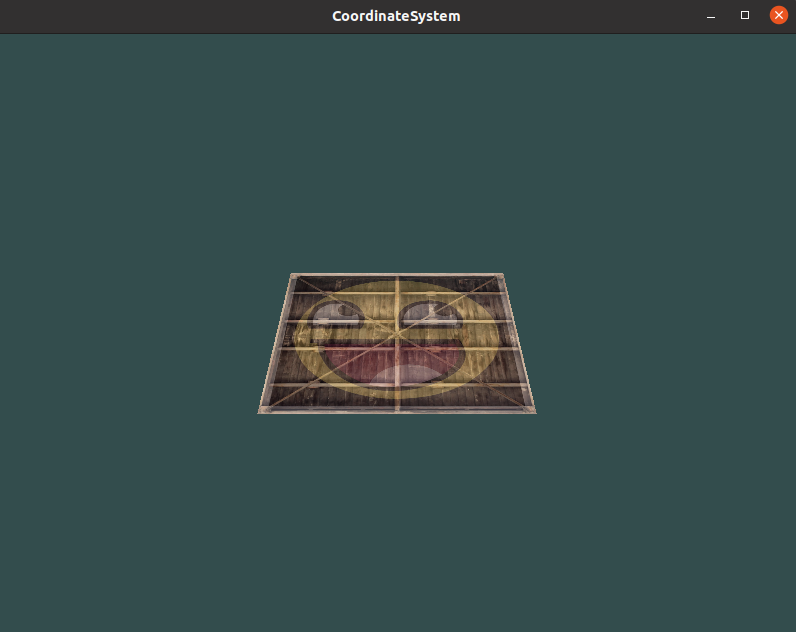
4. 立体化
构建一个立体的箱子:
设置立方体的六个面(12个三角形,36个点):
float vertices[] = { -0.5f, -0.5f, -0.5f, 0.0f, 0.0f, 0.5f, -0.5f, -0.5f, 1.0f, 0.0f, 0.5f, 0.5f, -0.5f, 1.0f, 1.0f, 0.5f, 0.5f, -0.5f, 1.0f, 1.0f, -0.5f, 0.5f, -0.5f, 0.0f, 1.0f, -0.5f, -0.5f, -0.5f, 0.0f, 0.0f, -0.5f, -0.5f, 0.5f, 0.0f, 0.0f, 0.5f, -0.5f, 0.5f, 1.0f, 0.0f, 0.5f, 0.5f, 0.5f, 1.0f, 1.0f, 0.5f, 0.5f, 0.5f, 1.0f, 1.0f, -0.5f, 0.5f, 0.5f, 0.0f, 1.0f, -0.5f, -0.5f, 0.5f, 0.0f, 0.0f, -0.5f, 0.5f, 0.5f, 1.0f, 0.0f, -0.5f, 0.5f, -0.5f, 1.0f, 1.0f, -0.5f, -0.5f, -0.5f, 0.0f, 1.0f, -0.5f, -0.5f, -0.5f, 0.0f, 1.0f, -0.5f, -0.5f, 0.5f, 0.0f, 0.0f, -0.5f, 0.5f, 0.5f, 1.0f, 0.0f, 0.5f, 0.5f, 0.5f, 1.0f, 0.0f, 0.5f, 0.5f, -0.5f, 1.0f, 1.0f, 0.5f, -0.5f, -0.5f, 0.0f, 1.0f, 0.5f, -0.5f, -0.5f, 0.0f, 1.0f, 0.5f, -0.5f, 0.5f, 0.0f, 0.0f, 0.5f, 0.5f, 0.5f, 1.0f, 0.0f, -0.5f, -0.5f, -0.5f, 0.0f, 1.0f, 0.5f, -0.5f, -0.5f, 1.0f, 1.0f, 0.5f, -0.5f, 0.5f, 1.0f, 0.0f, 0.5f, -0.5f, 0.5f, 1.0f, 0.0f, -0.5f, -0.5f, 0.5f, 0.0f, 0.0f, -0.5f, -0.5f, -0.5f, 0.0f, 1.0f, -0.5f, 0.5f, -0.5f, 0.0f, 1.0f, 0.5f, 0.5f, -0.5f, 1.0f, 1.0f, 0.5f, 0.5f, 0.5f, 1.0f, 0.0f, 0.5f, 0.5f, 0.5f, 1.0f, 0.0f, -0.5f, 0.5f, 0.5f, 0.0f, 0.0f, -0.5f, 0.5f, -0.5f, 0.0f, 1.0f };
开启深度测试:
glEnable(GL_DEPTH_TEST);
清除深度缓冲:
glClear(GL_COLOR_BUFFER_BIT | GL_DEPTH_BUFFER_BIT);
可选项,让箱子旋转:
model = glm::rotate(model, (float)glfwGetTime() * glm::radians(50.0f), glm::vec3(0.5f, 1.0f, 0.0f));
如果顺利的话,结果如下:
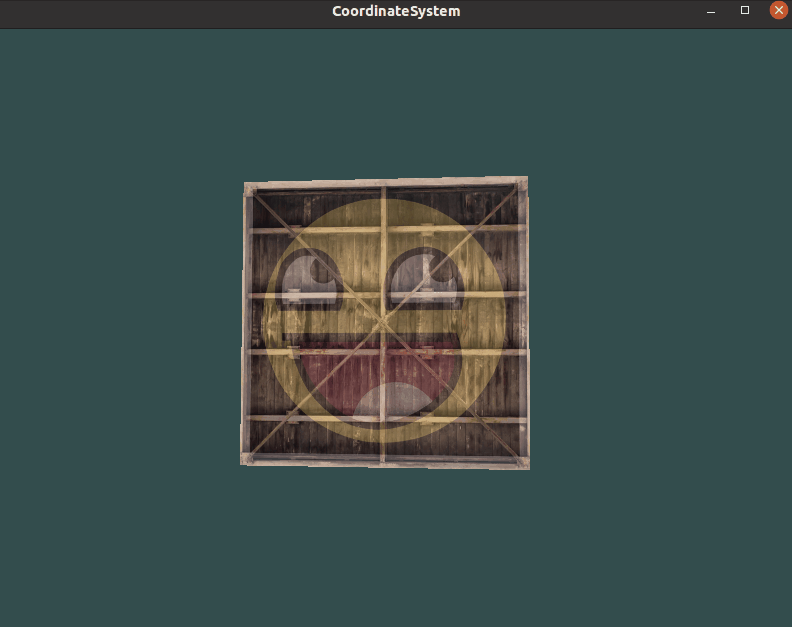
6. 多个立方体
这里的多个立方体实质就是指定(同一个立方体)平移到多个位置
设置多个位置:
glm::vec3 cubePositions[] = { glm::vec3( 0.0f, 0.0f, 0.0f), glm::vec3( 2.0f, 5.0f, -15.0f), glm::vec3(-1.5f, -2.2f, -2.5f), glm::vec3(-3.8f, -2.0f, -12.3f), glm::vec3( 2.4f, -0.4f, -3.5f), glm::vec3(-1.7f, 3.0f, -7.5f), glm::vec3( 1.3f, -2.0f, -2.5f), glm::vec3( 1.5f, 2.0f, -2.5f), glm::vec3( 1.5f, 0.2f, -1.5f), glm::vec3(-1.3f, 1.0f, -1.5f) };
绘制多个Model:
glBindVertexArray(VAO); for (unsigned int i = 0; i < 10; i++) { glm::mat4 model = glm::mat4(1.0f); model = glm::translate(model, cubePositions[i]); model = glm::rotate(model, (float)glfwGetTime() * glm::radians(50.0f), glm::vec3(1.0f, 0.3f, 0.5f)); glUniformMatrix4fv(modelLoc, 1, GL_FALSE, glm::value_ptr(model)); glDrawArrays(GL_TRIANGLES, 0, 36); }
实现效果:
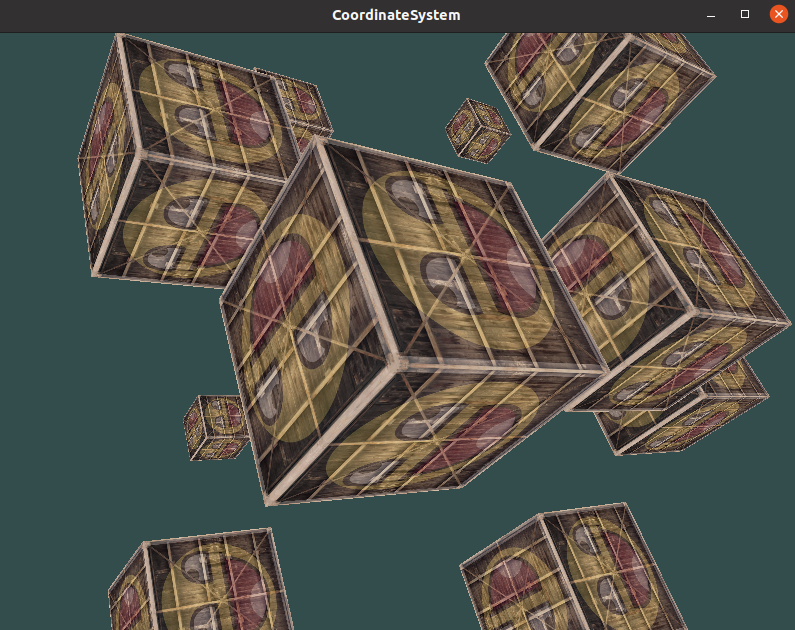
7. 完整代码
主要文件test.cpp:
#include <glad/glad.h> #include <GLFW/glfw3.h> #include <iostream> #include <math.h> #include "Shader.hpp" #define STB_IMAGE_IMPLEMENTATION #include "stb_image.h" #include <glm/glm.hpp> #include <glm/ext/matrix_transform.hpp> // glm::translate, glm::rotate, glm::scale #include <glm/ext/matrix_clip_space.hpp> // glm::perspective #include <glm/gtc/type_ptr.hpp> void framebuffer_size_callback(GLFWwindow *window, int width, int height); void process_input(GLFWwindow *window); unsigned int *renderInit(); void render(unsigned int shaderProgram, unsigned int VAO, unsigned int texture1, unsigned int texture2); bool checkCompile(unsigned int shader); bool checkProgram(unsigned int shaderProgram); int main() { glfwInit(); glfwWindowHint(GLFW_CONTEXT_VERSION_MAJOR, 3); glfwWindowHint(GLFW_CONTEXT_VERSION_MINOR, 3); GLFWwindow *window = glfwCreateWindow(800, 600, "CoordinateSystem", nullptr, nullptr); if (window == nullptr) { std::cout << "Faild to create window" << std::endl; glfwTerminate(); } glfwMakeContextCurrent(window); if (!gladLoadGLLoader((GLADloadproc)glfwGetProcAddress)) { std::cout << "Faild to initialize glad" << std::endl; return -1; } glad_glViewport(0, 0, 800, 600); glfwSetFramebufferSizeCallback(window, framebuffer_size_callback); unsigned int *arr = renderInit(); while (!glfwWindowShouldClose(window)) { process_input(window); // render std::cout << arr[0] << " " << arr[1] << " " << arr[2] << " " << arr[3] << " " << arr[4] << std::endl; render(arr[0], arr[1], arr[3], arr[4]); glfwSwapBuffers(window); glfwPollEvents(); } glDeleteProgram(arr[0]); glDeleteVertexArrays(1, &arr[1]); glDeleteBuffers(1, &arr[2]); glfwTerminate(); return 0; } void framebuffer_size_callback(GLFWwindow *window, int width, int height) { glViewport(0, 0, width, height); } void process_input(GLFWwindow *window) { if (glfwGetKey(window, GLFW_KEY_ESCAPE) == GLFW_PRESS) { glfwSetWindowShouldClose(window, true); } } unsigned int *renderInit() { //配置项 glEnable(GL_DEPTH_TEST); unsigned int VAO; glGenVertexArrays(1, &VAO); glBindVertexArray(VAO); unsigned int texture1; glGenTextures(1, &texture1); glBindTexture(GL_TEXTURE_2D, texture1); // 为当前绑定的纹理对象设置环绕、过滤方式 glTexParameteri(GL_TEXTURE_2D, GL_TEXTURE_WRAP_S, GL_REPEAT); glTexParameteri(GL_TEXTURE_2D, GL_TEXTURE_WRAP_T, GL_REPEAT); glTexParameteri(GL_TEXTURE_2D, GL_TEXTURE_MIN_FILTER, GL_LINEAR); glTexParameteri(GL_TEXTURE_2D, GL_TEXTURE_MAG_FILTER, GL_LINEAR); // 加载并生成纹理 int width, height, nrChannels; unsigned char *data = stbi_load("../container.jpg", &width, &height, &nrChannels, 0); if (data) { glTexImage2D(GL_TEXTURE_2D, 0, GL_RGB, width, height, 0, GL_RGB, GL_UNSIGNED_BYTE, data); glGenerateMipmap(GL_TEXTURE_2D); } else { std::cout << "Failed to load texture" << std::endl; } stbi_image_free(data); unsigned int texture2; glGenTextures(1, &texture2); glBindTexture(GL_TEXTURE_2D, texture2); // 为当前绑定的纹理对象设置环绕、过滤方式 glTexParameteri(GL_TEXTURE_2D, GL_TEXTURE_WRAP_S, GL_REPEAT); glTexParameteri(GL_TEXTURE_2D, GL_TEXTURE_WRAP_T, GL_REPEAT); glTexParameteri(GL_TEXTURE_2D, GL_TEXTURE_MIN_FILTER, GL_LINEAR); glTexParameteri(GL_TEXTURE_2D, GL_TEXTURE_MAG_FILTER, GL_LINEAR); // // 加载并生成纹理 int width2, height2, nrChannels2; stbi_set_flip_vertically_on_load(true); unsigned char *data2 = stbi_load("../awesomeface.png", &width2, &height2, &nrChannels2, 0); if (data2) { glTexImage2D(GL_TEXTURE_2D, 0, GL_RGBA, width2, height2, 0, GL_RGBA, GL_UNSIGNED_BYTE, data2); glGenerateMipmap(GL_TEXTURE_2D); } else { std::cout << "Failed to load texture" << std::endl; } stbi_image_free(data2); float vertices[] = { -0.5f, -0.5f, -0.5f, 0.0f, 0.0f, 0.5f, -0.5f, -0.5f, 1.0f, 0.0f, 0.5f, 0.5f, -0.5f, 1.0f, 1.0f, 0.5f, 0.5f, -0.5f, 1.0f, 1.0f, -0.5f, 0.5f, -0.5f, 0.0f, 1.0f, -0.5f, -0.5f, -0.5f, 0.0f, 0.0f, -0.5f, -0.5f, 0.5f, 0.0f, 0.0f, 0.5f, -0.5f, 0.5f, 1.0f, 0.0f, 0.5f, 0.5f, 0.5f, 1.0f, 1.0f, 0.5f, 0.5f, 0.5f, 1.0f, 1.0f, -0.5f, 0.5f, 0.5f, 0.0f, 1.0f, -0.5f, -0.5f, 0.5f, 0.0f, 0.0f, -0.5f, 0.5f, 0.5f, 1.0f, 0.0f, -0.5f, 0.5f, -0.5f, 1.0f, 1.0f, -0.5f, -0.5f, -0.5f, 0.0f, 1.0f, -0.5f, -0.5f, -0.5f, 0.0f, 1.0f, -0.5f, -0.5f, 0.5f, 0.0f, 0.0f, -0.5f, 0.5f, 0.5f, 1.0f, 0.0f, 0.5f, 0.5f, 0.5f, 1.0f, 0.0f, 0.5f, 0.5f, -0.5f, 1.0f, 1.0f, 0.5f, -0.5f, -0.5f, 0.0f, 1.0f, 0.5f, -0.5f, -0.5f, 0.0f, 1.0f, 0.5f, -0.5f, 0.5f, 0.0f, 0.0f, 0.5f, 0.5f, 0.5f, 1.0f, 0.0f, -0.5f, -0.5f, -0.5f, 0.0f, 1.0f, 0.5f, -0.5f, -0.5f, 1.0f, 1.0f, 0.5f, -0.5f, 0.5f, 1.0f, 0.0f, 0.5f, -0.5f, 0.5f, 1.0f, 0.0f, -0.5f, -0.5f, 0.5f, 0.0f, 0.0f, -0.5f, -0.5f, -0.5f, 0.0f, 1.0f, -0.5f, 0.5f, -0.5f, 0.0f, 1.0f, 0.5f, 0.5f, -0.5f, 1.0f, 1.0f, 0.5f, 0.5f, 0.5f, 1.0f, 0.0f, 0.5f, 0.5f, 0.5f, 1.0f, 0.0f, -0.5f, 0.5f, 0.5f, 0.0f, 0.0f, -0.5f, 0.5f, -0.5f, 0.0f, 1.0f}; unsigned int VBO; glGenBuffers(1, &VBO); glBindBuffer(GL_ARRAY_BUFFER, VBO); glBufferData(GL_ARRAY_BUFFER, sizeof(vertices), vertices, GL_STATIC_DRAW); glVertexAttribPointer(0, 3, GL_FLOAT, GL_FALSE, 5 * sizeof(float), (void *)0); glEnableVertexAttribArray(0); glVertexAttribPointer(1, 2, GL_FLOAT, GL_FALSE, 5 * sizeof(float), (void *)(3 * sizeof(float))); glEnableVertexAttribArray(1); Shader shaderProgram = Shader("../test.vs.glsl", "../test.fs.glsl"); shaderProgram.use(); glUniform1i(glGetUniformLocation(shaderProgram.ID, "texture1"), 0); glUniform1i(glGetUniformLocation(shaderProgram.ID, "texture2"), 1); return new unsigned int[5]{shaderProgram.ID, VAO, VBO, texture1, texture2}; } void render(unsigned int shaderProgram, unsigned int VAO, unsigned int texture1, unsigned int texture2) { glClearColor(0.2, 0.3, 0.3, 1.0); glClear(GL_COLOR_BUFFER_BIT | GL_DEPTH_BUFFER_BIT); glActiveTexture(GL_TEXTURE0); glBindTexture(GL_TEXTURE_2D, texture1); glActiveTexture(GL_TEXTURE1); glBindTexture(GL_TEXTURE_2D, texture2); glUseProgram(shaderProgram); glm::vec3 cubePositions[] = { glm::vec3(0.0f, 0.0f, 0.0f), glm::vec3(2.0f, 5.0f, -15.0f), glm::vec3(-1.5f, -2.2f, -2.5f), glm::vec3(-3.8f, -2.0f, -12.3f), glm::vec3(2.4f, -0.4f, -3.5f), glm::vec3(-1.7f, 3.0f, -7.5f), glm::vec3(1.3f, -2.0f, -2.5f), glm::vec3(1.5f, 2.0f, -2.5f), glm::vec3(1.5f, 0.2f, -1.5f), glm::vec3(-1.3f, 1.0f, -1.5f)}; glm::mat4 view = glm::mat4(1.0f); // 注意,我们将矩阵向我们要进行移动场景的反方向移动。 view = glm::translate(view, glm::vec3(0.0f, 0.0f, -3.0f)); glm::mat4 projection = glm::mat4(1.0f); projection = glm::perspective(glm::radians(45.0f), 800.0f / 600.0f, 0.1f, 100.0f); // 模型矩阵 int modelLoc = glGetUniformLocation(shaderProgram, "model"); // 观察矩阵 int viewLoc = glGetUniformLocation(shaderProgram, "view"); glUniformMatrix4fv(viewLoc, 1, GL_FALSE, glm::value_ptr(view)); // 投影矩阵 int projectionLoc = glGetUniformLocation(shaderProgram, "projection"); glUniformMatrix4fv(projectionLoc, 1, GL_FALSE, glm::value_ptr(projection)); glBindVertexArray(VAO); for (unsigned int i = 0; i < 10; i++) { glm::mat4 model = glm::mat4(1.0f); model = glm::translate(model, cubePositions[i]); float angle = 20.0f * (i + 1); model = glm::rotate(model, (float)glfwGetTime() * glm::radians(50.0f), glm::vec3(1.0f, 0.3f, 0.5f)); glUniformMatrix4fv(modelLoc, 1, GL_FALSE, glm::value_ptr(model)); glDrawArrays(GL_TRIANGLES, 0, 36); } }
顶点着色器test.vs.glsl:
#version 330 core layout (location = 0) in vec3 aPos; layout (location = 1) in vec2 aTexCoord; out vec2 TexCoord; uniform mat4 model; uniform mat4 view; uniform mat4 projection; void main() { // 注意乘法要从右向左读 gl_Position = projection * view * model * vec4(aPos, 1.0); TexCoord = aTexCoord; }
片段着色器test.fs.glsl:
#version 330 core out vec4 FragColor; in vec2 TexCoord; uniform sampler2D texture1; uniform sampler2D texture2; void main() { FragColor = mix(texture(texture1, TexCoord), texture(texture2, TexCoord), 0.2); }
8. 参考资料
[1]坐标系统 - LearnOpenGL CN (learnopengl-cn.github.io)



 本文基于C++语言,描述OpenGL的坐标系统
本文基于C++语言,描述OpenGL的坐标系统



【推荐】国内首个AI IDE,深度理解中文开发场景,立即下载体验Trae
【推荐】编程新体验,更懂你的AI,立即体验豆包MarsCode编程助手
【推荐】抖音旗下AI助手豆包,你的智能百科全书,全免费不限次数
【推荐】轻量又高性能的 SSH 工具 IShell:AI 加持,快人一步
· 分享4款.NET开源、免费、实用的商城系统
· 全程不用写代码,我用AI程序员写了一个飞机大战
· MongoDB 8.0这个新功能碉堡了,比商业数据库还牛
· 白话解读 Dapr 1.15:你的「微服务管家」又秀新绝活了
· 记一次.NET内存居高不下排查解决与启示